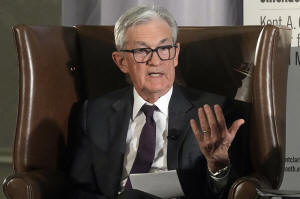Fed Chair Powell says interest rates on hold with economic uncertainty
widespread
[March 08, 2025] By
CHRISTOPHER RUGABER
NEW YORK (AP) — The Federal Reserve is likely to keep its key interest
rate unchanged in the coming months as it waits for widespread
“uncertainty” stemming from President Donald Trump's policies to
resolve, Chair Jerome Powell said Friday at a conference in New York.
Powell said the Trump administration is making policy changes in several
areas, including trade, taxes, government spending, immigration and
regulation, and added that the “net effect” of those changes are what
will matter for the economy and the Fed's interest rate policies.
“While there have been recent developments in some of these areas,
especially trade policy, uncertainty around the changes and their likely
effects remains high,” Powell said. “As we parse the incoming
information, we are focused on separating the signal from the noise as
the outlook evolves. We do not need to be in a hurry, and are well
positioned to wait for greater clarity.”
Most economists say that Trump's plans to slap tariffs on a wide array
of imports, including 25% duties on goods from Canada and Mexico that he
partially delayed Thursday, will push up prices and slow growth. But
many also expect that tax cuts and deregulation could boost the economy.
Powell’s comments pushed some traders to pare back their forecasts for
how many interest rate cuts the Fed may deliver this year. They had been
banking on at least three following a stream of weaker-than-expected
reports on the U.S. economy. But Powell reiterated the Fed is likely on
hold for a while. That sent Treasury yields higher in the bond market.
Rate reductions could help bring down borrowing costs for mortgages,
auto loans, credit cards, and business loans.

Powell, in a question and answer session, acknowledged that typically
tariffs would cause a “one-time” price increase, rather than persistent
inflation, and the Fed could ignore such a temporary effect. Treasury
Secretary Scott Bessent on Thursday made a similar argument: “We could
get a one-time price adjustment,” Bessent said, before adding, “I'm not
worried about inflation.”
Yet Powell also said there were other considerations the Fed has to take
into account when deciding whether to keep its rate unchanged, or even
raise rates. For example, Powell suggested tariffs might have more than
just a one-time impact "if it turns into a series” of tariff hikes, or
“if the increases are larger, that would matter.”
“What really does matter is what is happening with long-term inflation
expectations,” Powell added. Powell noted that shorter-term expectations
have risen, partly out of concern about tariffs, though longer-term
expectations have been stable.
Expectations that prices will rise can worsen inflation if they cause
consumers and businesses to change their behavior in anticipation. Some
companies might charge more when they expect their own costs to
increase.
[to top of second column] |

Federal Reserve Chair Jerome Powell speaks during the annual U.S.
Monetary Policy Forum, in New York, Friday, March 7, 2025. (AP
Photo/Richard Drew)
 When Trump imposed tariffs in his
last administration, Powell noted, the Fed ended up reducing its key
rate, “because growth weakened so much.”
Powell said the economy remains mostly healthy despite “elevated
uncertainty.” He characterized Friday's jobs report, which showed
employers added 151,000 jobs and the unemployment rate ticked up to
4.1%, as in line with the “solid” gains of the past six months.
He also noted that there were signs consumer spending has slowed
compared with the healthy gains in the second half of last year, and
said surveys of consumers and businesses “point to heightened
uncertainty about the economic outlook.” Further complicating
matters, he acknowledged that measures of consumer sentiment “have
not been a good predictor” of consumer spending in recent years.
The Fed's own beige book, a collection of anecdotes from hundreds of
businesses, mentioned uncertainty 47 times in its latest edition
released Wednesday, up from just 17 times in January. The Fed
publishes the beige book eight times a year.
Powell spoke at a conference organized by the University of
Chicago’s Booth School of Business.
President Donald Trump's on-again, off-again tariff policy and
rapid-fire layoffs of government workers has created a spike in
uncertainty among businesses and caused a sharp drop in consumer
confidence. Many economists have marked down their estimates for the
economy's growth to as low as 1% at an annual rate in the first
three months of this year, down from 2.3% in last year's final
quarter.
Yet as Fed governor Christopher Waller noted Thursday, there are
“good news” cuts and “bad news” cuts. “Bad news” cuts occur if the
Fed reduces rates out of concern that the economy is slowing, while
“good news” reductions are those that reflect a sense by the Fed
that inflation is returning to its target of 2%.
Waller added that he still believes it will be possible for the Fed
to engineer “good news” rate cuts later this year, though he
dismissed the potential for a cut at the Fed's next meeting this
month.
After cutting its key rate three times last year to about 4.3%,
Powell indicated in January that the Fed would pause any further
cuts amid signs that inflation has remained stuck above its target.
The central bank's preferred inflation gauge shows that prices rose
2.5% in January compared with a year ago. Excluding the volatile
food and energy categories, core prices rose 2.6%, the smallest
increase since June.
All contents © copyright 2025 Associated Press. All rights reserved |